

The
Research Project
The Study Area
Background Information
Tools Of The Trade
A Day In The Life Of . . .
Friday, December 7, 2001
Vegetation Plots—What Fun!
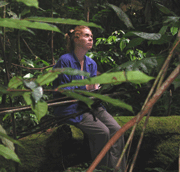 This
morning Lindsay decided to give us a break walking the trails and instead
do a "veg plot", as she affectionately calls them. We thought we were in
for an easy morning. What could be so difficult about marking off an area
of ground and counting the trees in it? Absolutely everything, it turns
out!
This
morning Lindsay decided to give us a break walking the trails and instead
do a "veg plot", as she affectionately calls them. We thought we were in
for an easy morning. What could be so difficult about marking off an area
of ground and counting the trees in it? Absolutely everything, it turns
out!
Vegetation plots are done in areas where Lindsay has seen monkeys. Originally she was only going to do them when she saw Roloways but she has seen so few that she now does them wherever she has seen any type of monkey.
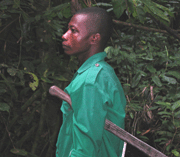 The
purpose of a veg plot is to try and determine monkeys' preferred habitat.
John, another wildlife ranger, always goes with her to identify the plants,
as he is an expert at it and there are few plants he doesn't know.
The
purpose of a veg plot is to try and determine monkeys' preferred habitat.
John, another wildlife ranger, always goes with her to identify the plants,
as he is an expert at it and there are few plants he doesn't know.
After Lindsay and John picked us up at 7:00 AM we headed down the trail. After a short time Lindsay suddenly stopped. Pointing to a particularly dense section of the forest she announced, "That is where I saw the monkeys and where we will do the veg plot."
We looked sideways at one another and were momentarily mortified as we realized that this survey was going to require hiking off the trail through extremely thick forest. Not to appear cowardly however, we took a deep breath, stepped off the trail and into the forest. John led the way with his cutlass (machete), whacking anything and everything in our way.
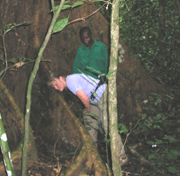 After climbing over and under all kinds of "stuff", we measured a 100 square
meter area and basically identified every tree in the plot. Should you have
any doubt - there are a whole bunch of trees in 100 square meters of rainforest!
We spent almost three hours tramping through the jungle identifying trees.
Of course with every step or placement of our hands we were thinking about
snakes. We really have no sense of how dangerous this really is—or
isn't, yet. To us, because we are new to this environment, this seems like
a pretty nutty thing to do. Yet, we take our cue from Lindsay and John.
After climbing over and under all kinds of "stuff", we measured a 100 square
meter area and basically identified every tree in the plot. Should you have
any doubt - there are a whole bunch of trees in 100 square meters of rainforest!
We spent almost three hours tramping through the jungle identifying trees.
Of course with every step or placement of our hands we were thinking about
snakes. We really have no sense of how dangerous this really is—or
isn't, yet. To us, because we are new to this environment, this seems like
a pretty nutty thing to do. Yet, we take our cue from Lindsay and John.
You may want to view the Daily Data section to learn about how vegetation plots are done and to see the data we are collecting.
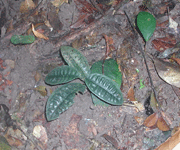 One
of the more interesting things we did see was a plant called psycotria ankasensis
which is native to this reserve and grows naturally no where else in the
world. The plant is mainly ornamental and is exported to Europe as a house
plant. Of course, we always see many insects—most of which are nameless.
One
of the more interesting things we did see was a plant called psycotria ankasensis
which is native to this reserve and grows naturally no where else in the
world. The plant is mainly ornamental and is exported to Europe as a house
plant. Of course, we always see many insects—most of which are nameless.
After the veg plot we hurried back to camp so that Lindsay could do a monkey survey. The trail she wanted to walk is her longest, taking 5-7 hours, walking at the pace of a snail. We had all decided it would be a good chance to catch up on our work instead of joining her.
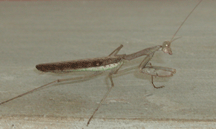 When
we got back we discovered that a large group of wildlife rangers had gone
down the same trail just hours before. Lindsay was very disappointed as
this meant that she couldn't do the walk today.
When
we got back we discovered that a large group of wildlife rangers had gone
down the same trail just hours before. Lindsay was very disappointed as
this meant that she couldn't do the walk today.
Instead of doing the survey Lindsay worked on transcribing her
data from 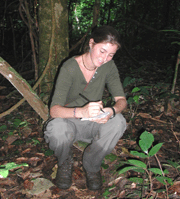 the
week before. When she is out in the field she records data in a small notebook.
Once back at camp she transcribes this into a larger notebook. She was doing
it on her computer but her computer no longer starts. The humidity is tough
on any electronic equipment here.
the
week before. When she is out in the field she records data in a small notebook.
Once back at camp she transcribes this into a larger notebook. She was doing
it on her computer but her computer no longer starts. The humidity is tough
on any electronic equipment here.
The afternoon was one of the hottest so far. The air was dead still. We did some writing, some reading and laundry. Doing laundry here is not as challenging as it was when we were in the Amazon. Last year we'd have to lean over the side of the boat and throw a bucket attached to a rope into the river. The trick was to haul the heavy bucket back up into the boat without being pulled overboard. This became particularly more difficult if the boat was moving. We didn't lose a single person though!
However, just because it isn't life threatening here doesn't mean that doing laundry is a walk in the park either. Doing laundry in a bucket takes time and the yellow soap and the brown African dirt never really rinse out of our clothing, leaving everything looking dirty and feeling stiff. At least things smell a little bit better. Most of our clothes will have to be burned after the trip!
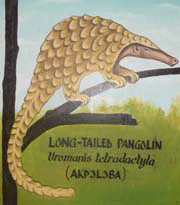 Shelly
and Michael decided to go for a run as they are both training for marathons.
Michael is training for the "Marathon des Sables ' (Marathon in the Sands)
held this upcoming April in Morocco. He is raising money for children with
Crones disease.
Shelly
and Michael decided to go for a run as they are both training for marathons.
Michael is training for the "Marathon des Sables ' (Marathon in the Sands)
held this upcoming April in Morocco. He is raising money for children with
Crones disease.
The distance from the camp to the gate is between 7 and 10 kilometers, depending on who you talk to of course. They filled up a water bottle and started their run. It was so hot that running actually felt cool since they were sweating and creating their own breeze as they ran. The only "animal encounters" they had were the columns of red fire ants crossing the road. These—we are all terrified of and everybody runs when we see them!
Scouting Survey
Early evening Lindsay wanted to do a scouting survey into an area of the reserve she had not yet been. Samuel, who must always accompany her, and Kevin went with her thinking it would be a short, easy scout. Well it wasn't and they got lost to boot!
At one point crossing the river Lindsay sunk up to her thighs in "quick mud". Kevin who was behind her, and sinking himself, had to hoist her from behind up onto the bank. As darkness fell and there was no sign of the trail they figured that there was a good chance they were going to spend the night in the jungle. Finally, using the compass, they headed east, crossed the river for the fourth time and found the road. They looked pretty bedraggled when they walked into camp. Kevin probably won't go on the morning survey with us!
When everyone was comfortably eating the wonderful dinner (Beef Jerky Cassoult - an Italian dish of beans, meat and wine) Michael had made for us, Lindsay asked if anyone was interested in joining her for another veg plot after the morning survey. I think we all said in unison, "What? Are you nuts?" Of course we were joking.... sort of!